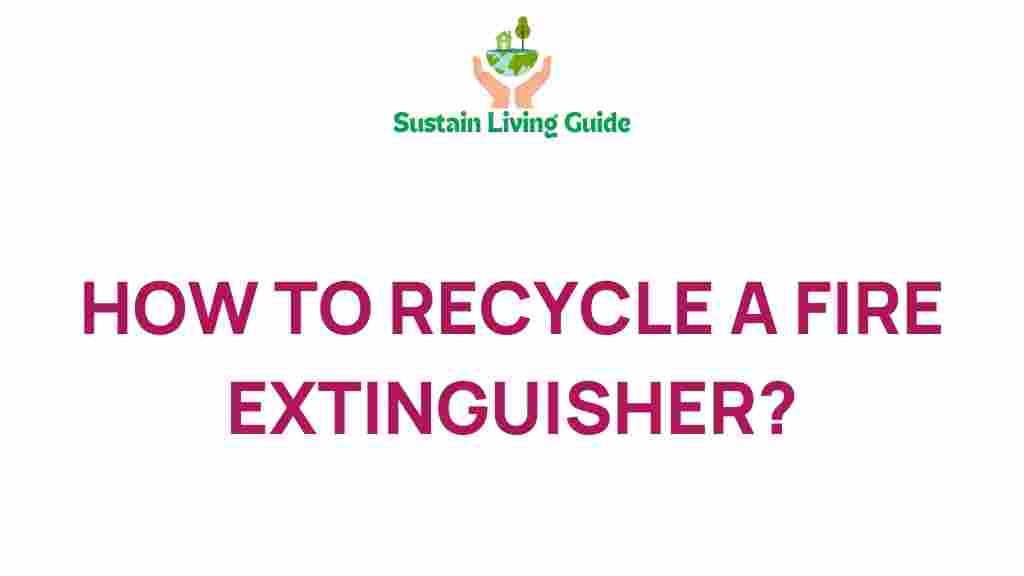Fire Extinguisher Recycling: Uncovering the Secrets
Fire extinguishers are crucial safety devices that protect lives and property from the devastating effects of fire. However, like all safety equipment, they have a lifespan and require proper disposal when they are no longer usable. Understanding how to recycle fire extinguishers not only helps you remain compliant with local regulations but also promotes environmental sustainability. In this article, we will explore the ins and outs of fire extinguisher recycling, providing you with a comprehensive guide to safely disposing of these essential tools.
Why Recycling Fire Extinguishers is Important
Recycling fire extinguishers is crucial for several reasons:
- Environmental Protection: Fire extinguishers contain chemicals and materials that can be harmful to the environment if not disposed of properly.
- Resource Recovery: Many components of fire extinguishers, such as metal and plastic, can be recycled and reused, reducing waste.
- Safety: Improper disposal can lead to hazardous situations, including accidental discharge or explosion.
Understanding the Types of Fire Extinguishers
Before diving into the recycling process, it’s essential to understand the different types of fire extinguishers, as their recycling methods may vary:
- Water-Based Extinguishers: Used primarily for Class A fires, these extinguishers can usually be recycled as scrap metal.
- Foam Extinguishers: These contain foam agents and require special handling during recycling.
- Dry Powder Extinguishers: Commonly used for Class B and C fires, these may need to be disposed of through specialized services.
- CO2 Extinguishers: Carbon dioxide extinguishers can be recycled, but the gas must be safely released first.
- Wet Chemical Extinguishers: Used for kitchen fires, these should be recycled through a professional service.
Step-by-Step Process of Fire Extinguisher Recycling
Recycling your fire extinguisher involves several steps to ensure safety and compliance. Follow this guide to recycle your fire extinguisher effectively:
Step 1: Check the Expiration Date
Before considering recycling, check if your fire extinguisher is expired. Most extinguishers have a lifespan of 5 to 15 years. If it’s still within its service life, consider having it inspected instead.
Step 2: Contact Local Authorities
Reach out to your local waste management authority or fire department. They can provide information on recycling programs specific to your region.
Step 3: Locate a Certified Recycling Center
Find a certified recycling center that handles fire extinguishers. Some common options include:
- Hazardous waste facilities
- Fire equipment suppliers
- Local recycling programs
Step 4: Prepare the Fire Extinguisher for Recycling
Before dropping off your fire extinguisher:
- Ensure it’s Empty: If your extinguisher is still pressurized, carefully release the pressure. Consult a professional if unsure.
- Remove the Hose: If possible, detach the hose and nozzle, as they may need separate handling.
- Label It: Clearly mark the extinguisher as “empty” to alert recyclers.
Step 5: Drop Off at the Recycling Center
Take your prepared fire extinguisher to the designated recycling center. Follow any specific instructions given by the facility to ensure safe and compliant recycling.
Step 6: Consider Replacement Options
If you are recycling an extinguisher, consider replacing it with a new one. Look for modern, eco-friendly fire extinguishers that comply with current safety standards.
Troubleshooting Common Issues in Fire Extinguisher Recycling
While recycling fire extinguishers is straightforward, you may encounter some common issues:
- Expired Fire Extinguisher Not Accepted: If your local center does not accept expired extinguishers, check if they have a specific disposal day or event.
- Pressure Issues: If your extinguisher is still pressurized and you’re unsure how to safely release it, contact a fire safety professional.
- Transport Issues: Ensure the extinguisher is securely stored during transportation to prevent accidental discharge.
Fire Extinguisher Maintenance Tips
Proper maintenance can extend the life of your fire extinguisher. Here are some tips:
- Regular Inspections: Check your extinguisher monthly for pressure and signs of damage.
- Annual Servicing: Have it serviced by a professional annually to ensure functionality.
- Recharge After Use: If you use your extinguisher, recharge it immediately, even if it appears to be empty.
Where to Learn More About Fire Extinguisher Recycling
For more detailed information on fire extinguisher recycling, you can visit this resource that provides guidelines and local resources.
Conclusion
Recycling fire extinguishers is a vital part of responsible fire safety management. By following the steps outlined in this article, you can ensure that your fire extinguishers are disposed of safely and sustainably. Remember, keeping your fire safety equipment in optimal condition and recycling responsibly can help protect the environment while maintaining safety in your home or workplace. For further assistance on fire extinguisher maintenance and recycling, consult your local fire department or fire safety expert.
By understanding the process and importance of fire extinguisher recycling, you contribute to a safer and more sustainable future for everyone.
This article is in the category Waste and created by SustainLivingGuide Team

2 thoughts on “Uncovering the Secrets of Fire Extinguisher Recycling”